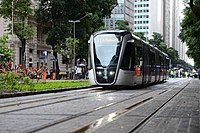Light rail
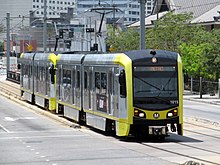
Light rail (or light rail transit, abbreviated to LRT) is a form of passenger urban rail transit that uses rolling stock derived from tram technology[1] while also having some features from heavy rapid transit.
The term was coined in 1972 in the United States as an English equivalent for the German word Stadtbahn, meaning "city railway".[2][3] Different definitions exist in some countries, but in the United States, light rail operates primarily along exclusive rights-of-way and uses either individual tramcars or multiple units coupled together, with a lower capacity and speed than a long heavy rail passenger train or rapid transit system.[4][5][6][7][8]
Narrowly defined, light rail transit uses rolling stock that is similar to that of a traditional tram, while operating at a higher capacity and speed, often on an exclusive right-of-way. In broader use, it includes tram-like operations mostly on streets.[9] A few light rail networks have characteristics closer to rapid transit or even commuter rail, yet only when these systems are fully grade-separated are they referred to as light metros.
| Part of a series on |
| Rail transport |
|---|
 |
|
|
| Infrastructure |
|
|
| Service and rolling stock |
|
| Special systems |
|
|
| Miscellanea |
|
|
Definition
[edit]The term light rail was coined in 1972 by the U.S. Urban Mass Transportation Administration (UMTA; the precursor to the Federal Transit Administration) to describe new streetcar transformations that were taking place in Europe and the United States. In Germany, the term Stadtbahn (to be distinguished from S-Bahn, which stands for Stadtschnellbahn) was used to describe the concept, and many in UMTA wanted to adopt the direct translation, which is city rail (the Norwegian term, by bane, means the same). However, UMTA finally adopted the term light rail instead.[10] Light in this context is used in the sense of "intended for light loads and fast movement", rather than referring to physical weight. The infrastructure investment is also usually lighter than would be found for a heavy rail system.
The American Public Transportation Association (APTA), in its Glossary of Transit Terminology, defines light rail as:
...a mode of transit service (also called streetcar, tramway, or trolley) operating passenger rail cars singly (or in short, usually two-car or three-car, trains) on fixed rails in the right-of-way that is often separated from other traffic for part or much of the way. Light rail vehicles are typically driven electrically with power being drawn from an overhead electric line via a trolley [pole] or a pantograph; driven by an operator onboard the vehicle; and may have either high platform loading or low-level boarding using steps."[4]
However, some diesel-powered transit is designated light rail, such as the O-Train Trillium Line in Ottawa, Ontario, Canada, the River Line in New Jersey, United States, and the Sprinter in California, United States, which use diesel multiple unit (DMU) cars.
Light rail is similar to the British English term light railway, long-used to distinguish railway operations carried out under a less rigorous set of regulations using lighter equipment at lower speeds from mainline railways. Light rail is a generic international English phrase for types of rail systems using modern streetcars/trams, which means more or less the same thing throughout the English-speaking world.
People movers are even "lighter", in terms of capacity. Monorail is a separate technology that has been more successful in specialized services than in a commuter transit role.[11]
British English versus American English
[edit]The use of the generic term light rail avoids some serious incompatibilities between British and American English. The word tram, for instance, is generally used in the UK and many former British colonies to refer to what is known in North America as a streetcar, but in North America tram can instead refer to an aerial tramway,[12] or, in the case of the Disney amusement parks, even a land train.[13] (The usual British term for an aerial tramway is cable car, which in the US usually refers to a ground-level car pulled along by subterranean cables.) The word trolley is often used as a synonym for streetcar in the United States but is usually taken to mean a cart, particularly a shopping cart, in the UK and elsewhere.[14] Many North American transportation planners reserve streetcar for traditional vehicles that operate exclusively in mixed traffic on city streets, while they use light rail to refer to more modern vehicles operating mostly in exclusive rights of way, since they may operate both side-by-side targeted at different passenger groups.[15]
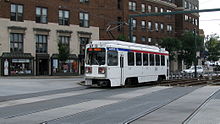
The difference between British English and American English terminology arose in the late 19th century when Americans adopted the term "street railway", rather than "tramway", with the vehicles being called "streetcars" rather than "trams". Some have suggested that the Americans' preference for the term "street railway" at that time was influenced by German emigrants to the United States[16] (who were more numerous than British immigrants in the industrialized Northeast), as it is the same as the German term for the mode, Straßenbahn (meaning "street railway"). A further difference arose because, while Britain abandoned all of its trams after World War II except in Blackpool, eight major North American cities (Toronto, Boston, Philadelphia, San Francisco, Pittsburgh, Newark, Cleveland, and New Orleans) continued to operate large streetcar systems.[17] When these cities upgraded to new technology, they called it light rail to differentiate it from their existing streetcars since some continued to operate both the old and new systems. Since the 1980s, Portland, Oregon, has built all three types of system: a high-capacity light rail system in dedicated lanes and rights-of-way, a low-capacity streetcar system integrated with street traffic, and an aerial tram system.
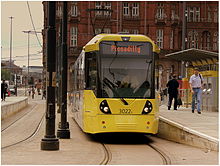
The opposite phrase heavy rail, used for higher-capacity, higher-speed systems, also avoids some incompatibilities in terminology between British and American English, for instance in comparing the London Underground and the New York City Subway. Conventional rail technologies including high-speed, freight, commuter, and rapid transit urban transit systems are considered "heavy rail". The main difference between light rail and heavy rail rapid transit is the ability for a light rail vehicle to operate in mixed traffic if the routing requires it.[18]
History
[edit]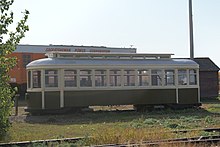
The world's first electric tram operated in Sestroretsk near Saint Petersburg, Russia, invented and operated on an experimental basis by Fyodor Pirotsky in 1880.[20][21] The first tramway was the Gross-Lichterfelde tramway in Lichterfelde near Berlin in Germany, which opened in 1881.[22] It was built by Werner von Siemens who contacted Pirotsky. It initially drew current from the rails, with overhead wire being installed in 1883. The first interurban to emerge in the United States was the Newark and Granville Street Railway in Ohio, which opened in 1889.[23] An early example of the light rail concept was the "Shaker Heights Rapid Transit" which started in the 1920s, was renovated in 1980-81 and is now part of RTA Rapid Transit.[24]
Postwar
[edit]Many original tram and streetcar systems in the United Kingdom, United States, and elsewhere were decommissioned starting in the 1950s as subsidies for the car increased. Britain abandoned its tram systems, except for Blackpool, with the closure of Glasgow Corporation Tramways (one of the largest in Europe) in 1962.[25]

Emergence
[edit]Although some traditional trolley or tram systems continued to exist in San Francisco and elsewhere, the term "light rail" has come to mean a different type of rail system as modern light rail technology has primarily post-WWII West German origins. An attempt by Boeing Vertol to introduce a new American light rail vehicle in the 1970s was proven to have been a technical failure by the following decade. After World War II, the Germans retained many of their streetcar networks and evolved them into model light rail systems (Stadtbahnen). With the exception of Hamburg, all large and most medium-sized German cities maintain light rail networks.[26]
The concept of a "limited tramway" was proposed by American transport planner H. Dean Quinby in 1962. Quinby distinguished this new concept in rail transportation from historic streetcar or tram systems as:[27]
- having the capacity to carry more passengers
- operating with "three-section, articulated" transit vehicles
- having more doors to facilitate full utilization of the space
- faster and quieter in operation
The term light rail transit was introduced in North America in 1972 to describe this new concept of rail transportation.[2] Prior to that time the abbreviation "LRT" was used for "Light Rapid Transit" and "Light Rail Rapid Transit".[28]
The first of the new light rail systems in North America began operation in 1978 when the Canadian city of Edmonton, Alberta, adopted the German Siemens-Duewag U2 system, followed three years later by Calgary, Alberta, and San Diego, California. The concept proved popular, with there now being numerous light rail systems in the United States and in North America.
In Britain, modern light rail systems began to appear in the 1980s, starting with the Tyne and Wear Metro from 1980 and followed by the Docklands Light Railway (DLR) in London in 1987, continuing into the 1990s including the establishment of the Manchester Metrolink in 1992 and the Sheffield Supertram from 1994.[29]
Types
[edit]Due to varying definitions, it is hard to distinguish between what is called light rail, and other forms of urban and commuter rail. A system described as a light rail in one city may be considered to be a streetcar or tram system in another. Conversely, some lines that are called "light rail" are very similar to rapid transit; in recent years, new terms such as light metro have been used to describe these medium-capacity systems. Some "light rail" systems, such as Sprinter, bear little similarity to urban rail, and could alternatively be classified as commuter rail or even inter-city rail. In the United States, "light rail" has become a catch-all term to describe a wide variety of passenger rail systems.
Light rail corridors may constitute a fully segregated corridor, a dedicated right-of-way on a street, an on-street corridor shared with other traffic, a corridor shared with other public transport, or a corridor shared with pedestrians.[30]
Lower capacity
[edit]The most difficult distinction to draw is that between low-floor light rail and streetcar or tram systems. There is a significant amount of overlap between the technologies; similar rolling stock may be used for either, and it is common to classify streetcars or trams as a subcategory of light rail rather than as a distinct type of transportation. However, some distinctions can be made, though systems may combine elements of both.[31]

Low-floor light rail lines tend to follow a reserved right-of-way and with trains receiving priority at intersections, and tend not to operate in mixed traffic, enabling higher operating speeds.[31][32] Light rail lines tend to have less frequent stops than tramways, and operate over a longer distance.[33] Light rail cars are often coupled into multiple units of two to four cars.[32]
Higher capacity
[edit]
Light rail systems may also exhibit attributes of heavy rail systems, including having downtown subways, as in San Francisco and Seattle. Light rail is designed to address a gap in interurban transportation between heavy rail and bus services, carrying high passenger numbers more quickly than local buses and more cheaply than heavy rail. It serves corridors in which heavy rail is impractical. Light metro systems are essentially hybrids of light rail and rapid transit.[11][34]
Metro trains are larger and faster than light rail trains, with stops being further apart.[35]
Mixed systems
[edit]Many systems have mixed characteristics. Indeed, with proper engineering, a rail line could run along a street, then go underground, and then run along an elevated viaduct. For example, the Los Angeles Metro Rail's A Line "light rail" has sections that could alternatively be described as a tramway, a light metro, and, in a narrow sense, rapid transit. This is especially common in the United States, where there is not a popularly perceived distinction between these different types of urban rail systems. The development of technology for low-floor and catenary-free trams facilitates the construction of such mixed systems with only short and shallow underground sections below critical intersections as the required clearance height can be reduced significantly compared to conventional light rail vehicles.[36]
Speed and stop frequency
[edit]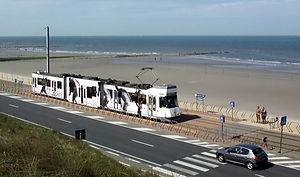
Reference speed from major light rail systems, including station stop time, is shown below.[37]
| System | Average speed (mph) | Average speed (km/h) |
|---|---|---|
| Baltimore | 24 | 39 |
| Dallas (Red Line) | 21 | 34 |
| Dallas (Blue Line) | 19 | 31 |
| Denver (Alameda-Littleton) | 38 | 61 |
| Denver (Downtown-Littleton) | 26 | 42 |
| Los Angeles (Blue Line) | 24 | 39 |
| Los Angeles (Green Line) | 38 | 61 |
| Salt Lake City | 24 | 39 |
However, low top speed is not always a differentiating characteristic between light rail and other systems. For example, the Siemens S70 LRVs used in the Houston METRORail and other North American LRT systems have a top speed of 55–71.5 miles per hour (88.51–115.1 km/h) depending on the system, while the trains on the all-underground Montreal Metro can only reach a top speed of 72 kilometres per hour (44.74 mph). LACMTA light rail vehicles have higher top and average speeds than Montreal Metro or New York City Subway trains.[38]
System-wide considerations
[edit]
Many light rail systems—even fairly old ones—have a combination of both on- and off-road sections. In some countries (especially in Europe), only the latter is described as light rail. In those places, trams running on mixed rights-of-way are not regarded as a light rail but considered distinctly as streetcars or trams. However, the requirement for saying that a rail line is "separated" can be quite low—sometimes just with concrete "buttons" to discourage automobile drivers from getting onto the tracks. Some systems such as Seattle's Link had on-road mixed sections but were closed to regular road traffic, with light rail vehicles and buses both operating along a common right-of-way (however, Link converted to full separation in 2019).
Some systems, such as the AirTrain JFK in New York City, the DLR in London, and Kelana Jaya Line in Kuala Lumpur, have dispensed with the need for an operator. The Vancouver SkyTrain was an early adopter of driverless vehicles, while the Toronto Scarborough rapid transit operated the same trains as Vancouver, but used drivers. In most discussions and comparisons, these specialized systems are generally not considered light rail but as light metro systems.
Variations
[edit]Light rail operating on mainline railways
[edit]
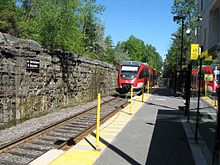
Around Karlsruhe, Kassel, and Saarbrücken in Germany, dual-voltage light rail trains partly use mainline railroad tracks, sharing these tracks with heavy rail trains. In the Netherlands, this concept was first applied on the RijnGouweLijn. This allows commuters to ride directly into the city center, rather than taking a mainline train only as far as a central station and then having to change to a tram. In France, similar tram-trains are planned for Paris, Mulhouse, and Strasbourg; further projects exist. In some cases, tram trains use previously abandoned or lightly used heavy rail lines in addition to or instead of still in use mainline tracks. In 2022, Spain opened the Cádiz TramBahia, where trams share track with commuter and long-distance trains from the main terminus in the city and curve off to serve cities without a railway connection.
Some of the issues involved in such schemes are:
- compatibility of the safety systems
- power supply of the track to the power used by the vehicles (frequently different voltages, rarely third rail vs overhead wires)
- width of the vehicles to the position of the platforms
- height of the platforms
There is a history of what would now be considered light rail vehicles operating on heavy rail rapid transit tracks in the US, especially in the case of interurban streetcars. Notable examples are Lehigh Valley Transit trains running on the Philadelphia and Western Railroad high-speed third rail line (now the Norristown High-Speed Line). Such arrangements are almost impossible now, due to the Federal Railroad Administration refusing (for crash safety reasons) to allow non-FRA compliant railcars (i.e., subway and light rail vehicles) to run on the same tracks at the same times as compliant railcars, which includes locomotives and standard railroad passenger and freight equipment. Notable exceptions in the US are the NJ Transit River Line from Camden to Trenton and Austin's Capital MetroRail, which have received exemptions to the provision that light rail operations occur only during daytime hours and Conrail freight service only at night, with several hours separating one operation from the other. The O-Train Trillium Line in Ottawa also has freight service at certain hours.
Comparison to other rail transit modes
[edit]With its mix of right-of-way types and train control technologies, LRT offers the widest range of latitude of any rail system in the design, engineering, and operating practices. The challenge in designing light rail systems is to realize the potential of LRT to provide fast, comfortable service while avoiding the tendency to overdesign that results in excessive capital costs beyond what is necessary to meet the public's needs.[39]
| Alternative | Differences |
|---|---|
| Rapid transit | Light rail vehicles (LRVs) are distinguished from rapid rail transit (RRT) vehicles by their capability for operation in mixed traffic, generally resulting in a narrower car body and articulation to operate in a street traffic environment. With their large size, large turning radius, and often an electrified third rail, RRT vehicles cannot operate in the street. Since LRT systems can operate in existing streets, they can often avoid the cost of expensive grade-separated subway and elevated segments that would be required with RRT. |
| Streetcars or trams | Conversely, LRVs generally outperform traditional streetcars in terms of capacity and top-end speed, and almost all modern LRVs are capable of multiple-unit operation. The latest generation of LRVs is considerably larger and faster, typically 29 metres (95 ft 1+3⁄4 in) long with a maximum speed of around 105 kilometres per hour (65.2 mph).[40] |
| Heritage streetcars | A variation considered by many cities is to use historic or replica cars on their streetcar systems instead of modern LRVs. A heritage streetcar may not have the capacity and speed of an LRV, but it will add to the ambiance and historic character of its location. |
| Light metro | A derivative of LRT is light rail rapid transit (LRRT), also referred to as light metro. Such railways are characterized by exclusive rights of way, advanced train control systems, short headway capability, and floor-level boarding. These systems approach the passenger capacity of full metro systems but can be cheaper to construct due to LRVs generally being smaller in size, turning tighter curves and climbing steeper grades than standard RRT vehicles, and having a smaller station size. |
| Interurbans | The term interurban mainly refers to rail cars that run through streets like ordinary streetcars (trams), but also between cities or towns, often through rural environments. In the period 1900–1930, interurbans were very common in the US, especially in the Midwest. Some of them, like the Red Devils, the J. G. Brill Bullets, and the Electroliners, were the high-speed railcars of their time, with an in-service speed of up to about 145 km/h (90 mph). In Europe, interurbans are making a comeback as "tram-trains" (locally known under different names) that operate on both the railway and light rail tracks, often with different voltages. The Karlsruhe Stadtbahn is one well-known example. |
Typical rolling stock
[edit]The BART railcar in the following chart is not generally considered to be a "light rail" vehicle (it is a heavy rail vehicle), and is only included for comparison purposes.
| Type | Rapid transit (heavy rail) | Light rail | Tram, or streetcar | Heritage streetcar |
|---|---|---|---|---|
| Manufacturer | Rohr | Siemens | Skoda | Gomaco Trolley Co. |
| Model | BART A-Car | S70 | 10T | Replica Birney |
| Width | 3.2 metres (10 ft 6 in) | 2.7 metres (8 ft 10+1⁄4 in) | 2.6 metres (8 ft 6+3⁄8 in) | 2.62 metres (8 ft 7+1⁄8 in) |
| Length | 22.9 metres (75 ft 1+5⁄8 in) | 27.7 metres (90 ft 10+1⁄2 in) articulated | 20.13 metres (66 ft 1⁄2 in) articulated | 15.16 metres (49 ft 8+7⁄8 in) |
| Weight (empty) | 63.1 t | 48.6 t[41] | 28.8 t | 23.5 t[42] |
| Capacity | 150 max. | 72 seats, 220 max.[41] | 30 seats, 157 max. | 40 seats, 50 max.[42] |
| Top speed | 125 km/h (77.7 mph) | 106 km/h (65.9 mph) | 70 km/h (43.5 mph) | 48 km/h (29.8 mph) |
| Typical consist | 4–10 vehicles | 2–5 vehicles | 1 vehicle | 1 vehicle |
Floor height
[edit]Low-floor LRVs have the advantage of a low-floor design, allowing them to load passengers directly from low-rise platforms that can be little more than raised curbs. High-floor light rail systems also exist, featuring larger stations.[31]
Infrastructure
[edit]Track gauge
[edit]Historically, the track gauge has had considerable variations, with narrow gauge common in many early systems. However, most light rail systems are now standard gauge.[26] Older standard-gauge vehicles could not negotiate sharp turns as easily as narrow-gauge ones, but modern light rail systems achieve tighter turning radii by using articulated cars. An important advantage of the standard gauge is that standard railway maintenance equipment can be used on it, rather than custom-built machinery. Using standard gauges also allows light rail vehicles to be conveniently moved around using the same tracks as freight railways. Additionally, wider gauges (e.g. standard gauge) provide more floor clearance on low-floor trams that have constricted pedestrian areas at the wheels, which is especially important for wheelchair access, as narrower gauges (e.g. metre gauge) can make it challenging or impossible to pass the tram's wheels. Furthermore, standard-gauge rolling stock can be switched between networks either temporarily or permanently, and both newly built and used standard-gauge rolling stock tends to be cheaper to buy, as more companies offer such vehicles.
Power sources
[edit]Overhead lines supply electricity to the vast majority of light rail systems.[4] This avoids the danger potentially presented by an electrified third rail.[35] The Docklands Light Railway uses an inverted third rail for its electrical power, which allows the electrified rail to be covered and the power drawn from the underside. Trams in Bordeaux, France, use a special third-rail configuration where the power is only switched on beneath the trams, making it safe on city streets. Several systems in Europe and a few recently opened systems in North America use diesel-powered trains.
Ground-level power supply for trams
[edit]When electric streetcars were introduced in the late 19th century, conduit current collection was one of the first ways of supplying power, but it proved to be much more expensive, complicated, and trouble-prone than overhead wires. When electric street railways became ubiquitous, conduit power was used in those cities that did not permit overhead wires. In Europe, it was used in London, Paris, Berlin, Marseille, Budapest, and Prague. In the United States, it was used in parts of New York City and Washington, D.C.[43] Third rail technology was investigated for use on the Gold Coast of Australia for the G:link light rail,[44] though power from overhead lines was ultimately utilized for that system.
In the French city of Bordeaux, the tramway network is powered by a third rail in the city center, where the tracks are not always segregated from pedestrians and cars.[45] The third rail (actually two closely spaced rails) is placed in the middle of the track and divided into eight-metre sections, each of which is powered only while it is completely covered by a tram. This minimizes the risk of a person or animal coming into contact with a live rail. In outer areas, the trams switch to conventional overhead wires. The Bordeaux power system costs about three times as much as a conventional overhead wire system and took 24 months to achieve acceptable levels of reliability, requiring the replacement of all the main cables and power supplies.[46] Operating and maintenance costs of the innovative power system still remain high. However, despite numerous service outages, the system was a success with the public, gaining up to 190,000 passengers per day.
Automatic train operation
[edit]Automatic train operation is employed on light rail networks, tracking the position and speed of a train and hence adjusting its movement for safety and efficiency.[47]
Comparison to road trafic
[edit]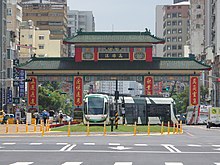
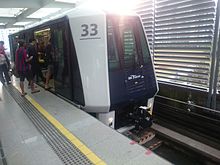
Comparison with high capacity roads
[edit]One line of light rail (requires 7.6 m, 25' right of way) has a theoretical capacity of up to 8 times more than one 3.7 m (12 foot) lane on a freeway, excluding busses, during peak times. Roads have ultimate capacity limits that can be determined by traffic engineering, and usually experience a chaotic breakdown inflow and a dramatic drop in speed (a traffic jam) if they exceed about 2,000 vehicles per hour per lane (each car roughly two seconds behind another).[48] Since most people who drive to work or on business trips do so alone, studies show that the average car occupancy on many roads carrying commuters is only about 1.5 people per car during the high-demand rush hour periods of the day.[49] This combination of factors limits roads carrying only automobile commuters to a maximum observed capacity of about 3,000 passengers per hour per lane. The problem can be mitigated by introducing high-occupancy vehicle (HOV) lanes and ride-sharing programs, but in most cases, policymakers have chosen to add more lanes to the roads, despite a small risk that in unfavorable situations an extension of the road network might lead to increased travel times (Downs–Thomson paradox, Braess's paradox).[50][51][52]
By contrast, light rail vehicles can travel in multi-car trains carrying a theoretical ridership up to 20,000 passengers per hour in much narrower rights-of-way, not much more than two car lanes wide for a double track system.[53] They can often be run through existing city streets and parks, or placed in the medians of roads. If run in streets, trains are usually limited by city block lengths to about four 180-passenger vehicles (720 passengers). Operating on two-minute headways using traffic signal progression, a well-designed two-track system can handle up to 30 trains per hour per track, achieving peak rates of over 20,000 passengers per hour in each direction. More advanced systems with separate rights-of-way using moving block signaling can exceed 25,000 passengers per hour per track.[54]
Practical considerations
[edit]Most light rail systems in the United States are limited by demand rather than capacity (by and large, most American LRT systems carry fewer than 4,000 persons per hour per direction), but Boston's and San Francisco's light rail lines carry 9,600 and 13,100 passengers per hour per track during rush hour.[55] Elsewhere in North America, the Calgary C-Train and Monterrey Metro have higher light rail ridership than Boston or San Francisco. Systems outside North America often have much higher passenger volumes. The Manila Light Rail Transit System is one of the highest capacity ones, having been upgraded in a series of expansions to handle 40,000 passengers per hour per direction, and having carried as many as 582,989 passengers in a single day on its Line 1.[56] It achieves this volume by running four-car trains with a capacity of up to 1,350 passengers each at a frequency of up to 30 trains per hour. However, the Manila light rail system has full grade separation and as a result, has many of the operating characteristics of a metro system rather than a light rail system. A capacity of 1,350 passengers per train is more similar to the heavy rail than light rail.
Bus rapid transit (BRT) is an alternative to LRT and many planning studies undertake a comparison of each mode when considering appropriate investments in transit corridor development. BRT systems can exhibit a more diverse range of design characteristics than LRT, depending on the demand and constraints that exist, and BRT using dedicated lanes can have a theoretical capacity of over 30,000 passengers per hour per direction (for example, the Guangzhou Bus Rapid Transit system operates up to 350 buses per hour per direction). For the effective operation of a bus or BRT system, buses must have priority at traffic lights and have their dedicated lanes, especially as bus frequencies exceed 30 buses per hour per direction. The higher theoretical of BRT relates to the ability of buses to travel closer to each other than rail vehicles and their ability to overtake each other at designated locations allowing express services to bypass those that have stopped at stations. However, to achieve capacities this high, BRT station footprints need to be significantly larger than a typical LRT station. In terms of cost of operation, each bus vehicle requires a single driver, whereas a light rail train may have three to four cars of much larger capacity in one train under the control of one driver, or no driver at all in fully automated systems, increasing the labor costs of BRT systems compared to LRT systems. BRT systems are also usually less fuel-efficient as they use non-electrified vehicles.
The peak passenger capacity per lane per hour depends on which types of vehicles are allowed on the roads. Typically roadways have 1,900 passenger cars per lane per hour (pcplph).[57] If only cars are allowed, the capacity will be less and will not increase when the traffic volume increases.
When there is a bus driving on this route, the capacity of the lane will be higher and will increase when the traffic level increases. And because the capacity of a light rail system is higher than that of a bus, there will be even more capacity when there is a combination of cars and light rail. Table 3 shows an example of peak passenger capacity.
| Car | Car + bus | Car + light rail | |
|---|---|---|---|
| Low volume | 900 | 1,650 | 2,250 |
| Medium volume | 900 | 2,350 | 3,250 |
| High volume | 900 | 3,400 | 4,600 |
| Source: Edson & Tennyson, 2003[full citation needed] | |||
Construction and operation costs
[edit]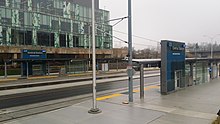
The cost of light rail construction varies widely, largely depending on the amount of tunneling and elevated structures required. A survey of North American light rail projects[58] shows that costs of most LRT systems range from $15 million to over $100 million per mile. Seattle's new light rail system is by far the most expensive in the US, at $179 million per mile, since it includes extensive tunneling in poor soil conditions, elevated sections, and stations as deep as 180 feet (55 m) below ground level.[59] This results in costs more typical of subways or rapid transit systems than light rail. At the other end of the scale, four systems (Baltimore, Maryland; Camden, New Jersey; Sacramento, California; and Salt Lake City, Utah) incurred construction costs of less than $20 million per mile. Over the US as a whole, excluding Seattle, new light rail construction costs average about $35 million per mile.[58]
By comparison, a freeway lane expansion typically costs $1.0 million to $8.5 million per lane mile for two directions, with an average of $2.3 million.[60] However, freeways are frequently built in suburbs or rural areas, whereas light rail tends to be concentrated in urban areas, where right of way and property acquisition is expensive. Similarly, the most expensive US highway expansion project was the "Big Dig" in Boston, Massachusetts, which cost $200 million per lane mile for a total cost of $14.6 billion. A light rail track can carry up to 20,000 people per hour as compared with 2,000–2,200 vehicles per hour for one freeway lane.[61] For example, in Boston and San Francisco, light rail lines carry 9,600 and 13,100 passengers per hour, respectively, in the peak direction during rush hour.[55]
Combining highway expansion with LRT construction can save costs by doing both highway improvements and rail construction at the same time. As an example, Denver's Transportation Expansion Project rebuilt interstate highways 25 and 225 and added a light rail expansion for a total cost of $1.67 billion over five years.[62] The cost of 17 miles (27 km) of highway improvements and 19 miles (31 km) of double-track light rail worked out to $19.3 million per highway lane-mile and $27.6 million per LRT track-mile. The project came in under budget and 22 months ahead of schedule.[63]
LRT cost efficiency improves dramatically as ridership increases, as can be seen from the numbers above: the same rail line, with similar capital and operating costs, is far more efficient if it is carrying 20,000 people per hour than if it is carrying 2,400. The Calgary, Alberta, C-Train used many common light rail techniques to keep costs low, including minimizing underground and elevated trackage, sharing transit malls with buses, leasing rights-of-way from freight railroads, and combining LRT construction with freeway expansion. As a result, Calgary ranks toward the less expensive end of the scale with capital costs of around $24 million per mile.[64]
However, Calgary's LRT ridership is much higher than any comparable US light rail system, at 300,000 passengers per weekday, and as a result, its capital efficiency is also much higher. Its capital costs were one-third those of the San Diego Trolley, a comparably sized US system built at the same time, while by 2009 its ridership was approximately three times as high. Thus, Calgary's capital cost per passenger was much lower than that of San Diego. Its operating cost per passenger was also much lower because of its higher ridership. A typical C-Train vehicle costs only CA$163 (equivalent to $235 in 2023) per hour to operate, and since it averages 600 passengers per operating hour,[65] Calgary Transit estimates that its LRT operating costs are only 27 cents per ride, versus $1.50 per ride on its buses.[64]
Compared to buses, costs can be lower due to lower labor costs per passenger mile, higher ridership (observations show that light rail attracts more ridership than a comparable bus service)[66] and faster average speed (reducing the number of vehicles needed for the same service frequency). While light rail vehicles are more expensive to buy, they have a longer useful life than buses, sometimes making for lower life-cycle costs. Compared to heavy rail investment costs are lower, however operating costs are higher than heavy rail.[67]
Efficiency
[edit]Energy efficiency for light rail may be 120 passenger miles per gallon of fuel (or equivalent), but variation is great, depending on circumstances.[68]
Effects
[edit]Safety
[edit]An analysis of data from the 505-page National Transportation Statistics report[69] published by the US Department of Transportation shows that light rail fatalities are higher than all other forms of transportation except motorcycle travel (31.5 fatalities per 100 million miles).[70]
However, the National Transportation Statistics report published by the US Department of Transportation states that:[69]
Caution must be exercised in comparing fatalities across modes because significantly different definitions are used. In particular, Rail and Transit fatalities include incident-related (as distinct from accident-related) fatalities, such as fatalities from falls in transit stations or railroad employee fatalities from a fire in a workshed. Equivalent fatalities for the Air and Highway modes (fatalities at airports not caused by moving aircraft or fatalities from accidents in automobile repair shops) are not counted toward the totals for these modes. Thus, fatalities not necessarily directly related to in-service transportation are counted for the transit and rail modes, potentially overstating the risk for these modes.
Health impact
[edit]Studies have attributed light rail with a number of health impacts. Research has associated light rail positively with increased walking and decreased obesity.[71][72] Additionally, one electric light rail train produces nearly 99 percent less carbon monoxide and hydrocarbon emissions per mile than one automobile does.[73]
Tram and light rail transit systems worldwide
[edit]Around the world, there are many extant tram and streetcar systems. Some date from the beginning of the 20th century or earlier such as Toronto streetcar system, but many of the original tram and streetcar systems were closed down in the mid-20th century, except for many Eastern European countries. Even though many systems closed down over the years, there are still several tram systems that have been operating much as they did when they were first built over a century ago. Some cities (such as Los Angeles and Jersey City) that once closed down their streetcar networks are now restoring, or have already rebuilt, at least some of their former streetcar/tram systems. Most light rail services are currently committed to articulated vehicles like modern LRVs, i.e. trams, except for large underground metro or rapid transit systems.[citation needed]
Several UK cities have substantial light rail networks including the Nottingham Express Transit, Sheffield Supertram, Manchester Metrolink.
A smaller network between Birmingham and The Black Country (West Midlands Metro), with plans to add 6 new lines and extend out to Stourbridge, Birmingham Airport & Walsall. Edinburgh Trams is also a single line route, currently looking to add other lines.[74]
-
A light-rail vehicle of the Newcastle Light Rail at Honeysuckle, an urban development in Newcastle, New South Wales
-
A light-rail vehicle on the Hämeenkatu street in Tampere
-
Metrotram in Kryvyi Rih (Ukraine) was separated from the streets, but later it was upgraded to be compatible with common tramways.
-
A light-rail vehicle of the VLT Carioca on Avenida Rio Branco in Rio de Janeiro, Brazil
-
The light rail in Tunis, Tunisia, was the first light rail system in Africa
See also
[edit]- General Motors streetcar conspiracy
- H-Bahn
- History of tram and light rail transit systems by country
- Light rail in North America
- List of modern tramway and light rail systems in the United Kingdom
- List of rail transit systems in the United States
- List of town tramway systems (all-time lists)
- List of tram and light rail transit systems
(operational systems only) - Medium-capacity rail system
- Passenger rail terminology
- Premetro
- Railway electrification
- Rubber-tyred tram
- Streetcars in North America
References
[edit]- ^ Vuchic, V.R. (1975). "Place of light rail transit in the family of transit modes". TRB Special Report (161). Transportation Research Board. Retrieved 1 July 2024. National Conference of the Transportation Research Board
- ^ a b Thompson, Gregory L. (2003). "Defining an Alternative Future: The Birth of the Light Rail Movement in North America". Transportation Research Circular (E-C058). Transportation Research Board. Retrieved 26 December 2009. From: 9th National Light Rail Transit Conference
- ^ "New railway bridge over the Neckar river". Retrieved 24 June 2024.
- ^ a b c "Fact Book Glossary – Mode of Service Definitions". American Public Transportation Association. 2015. Archived from the original on 25 February 2018. Retrieved 6 January 2015.
- ^ "National Transit Database Glossary". U.S. Department of Transportation Federal Transit Administration. 18 October 2013. Archived from the original on 13 November 2013. Retrieved 6 January 2015.
- ^ "What is light rail?". Public transport A-Z. International Association of Public Transport. 2008. Archived from the original on 13 October 2008. Retrieved 29 July 2015.
- ^ "This Is Light Rail Transit" (PDF). Transportation Research Board. pp. 7–9. Archived from the original (PDF) on 17 April 2018. Retrieved 6 January 2015.
- ^ "What is Light Rail?". Light Rail Transit Association (LRTA). Archived from the original on 5 June 2016. Retrieved 6 January 2015.
- ^ Glossary of Transit Terms. 1992. p. 9. Retrieved 24 June 2024.
- ^ Gregory L. Thompson (2003), Defining an Alternative Future: Birth of the Light Rail Movement in North America (PDF), Transportation Research Board.
- ^ a b Johnson, Matt (4 April 2019). "Light rail? Heavy rail? Subway? Rail transit modes fall on a continuum". Greater Greater Washington. Retrieved 24 July 2024.
- ^ "Tram (definition)". Merriam-Webster Online Dictionary. Retrieved 18 July 2007.
- ^ "The Yesterland Hotel Tram". Yesterland.com. Retrieved 7 February 2013.
- ^ "Trolley (definition)". Merriam-Webster Online Dictionary. Retrieved 18 July 2007.
- ^ "Light Rail Transit". Encyclopædia Britannica. Retrieved 18 July 2007.
- ^ Smiler, Simon P. "Trams, Streetcars, and Light Rail Vehicles". citytransport.info. Retrieved 18 July 2007.
- ^ Plous, F.K. Jr. (June 1984). "A Desire Named Streetcar". Planning. American Planning Association. Archived from the original on 3 March 2006. Retrieved 14 August 2007.
- ^ p.c., Metro Tech Consulting Services Engineering Architecture; Consultants, Track Guy (2012). Track Design Handbook for Light Rail Transit, Second Edition | Blurbs New | Blurbs | Publications. doi:10.17226/22800. ISBN 978-0-309-25824-1. Retrieved 15 February 2020.
{{cite book}}:|website=ignored (help) - ^ "Welcome to Saskrailmuseum.org". Saskatchewan Railway Museum. BlackNova Internet Services. 11 September 2008. Archived from the original on 15 October 2008. Retrieved 26 December 2009.
- ^ C. N. Pyrgidis. Railway Transportation Systems: Design, Construction, and Operation. CRC Press, 2016. p. 156
- ^ Ye. N. Petrova. St. Petersburg in Focus: Photographers of the Turn of the Century; in Celebration of the Tercentenary of St. Petersburg. Palace Ed., 2003. p. 12
- ^ "The Gross Lichterfelde Tramway was the worlds first electric tramway". Media Storehouse Photo Prints. Retrieved 18 July 2024.
- ^ Hilton, George W.; Due, John F. (2000). The electric interurban railways in America (1. paperback print ed.). Stanford, Calif: Stanford University Press. pp. 8–9. ISBN 978-0-8047-4014-2.
- ^ Middleton, William D. (2003). Metropolitan Railways: Rapid Transit in America. Indiana University Press. pp. 146, 147. ISBN 978-0-253-34179-2.
- ^ Courtenay, Peter (2006). "Trams in the UK". thetrams.co.uk. Retrieved 26 December 2009.
- ^ a b Bottoms, Glen (2000). Continuing Developments in Light Rail Transit in Western Europe (PDF). 9th National Light Rail Transit Conference. Portland, Oregon: Light Rail Transit Association. Retrieved 26 December 2009.
- ^ Quinby, Henry D. (January 1962). "Major Urban Corridor Facilities: A New Concept". Traffic Quarterly. 16 (1). Eno Foundation for Highway Traffic Control: 242–259. hdl:2027/uc1.$b3477.
- ^ Wright, Gerald (Fall 1972). Light Rapid Transit – the Immediate Answer for Edmonton. Edmonton, Alberta: The University Practicum in Rapid Transit – University of Alberta Extension Service.
- ^ Butcher, Louise (25 January 2012). "Railways: light rail schemes" (PDF). House of Commons Library. p. 2. Retrieved 24 July 2024.
- ^ "Light rail station infrastructure" (PDF). Department of Transport and Main Roads. p. 19.
- ^ a b c "Streetcars vs LRT". Edmonton Radial Railway Society. Retrieved 22 July 2024.
- ^ a b "Light Rail". Seashore Trolley Museum. Retrieved 22 July 2024.
- ^ Walker, Jarrett (26 March 2010). "Streetcars vs Light Rail ... Is There a Difference?". Human Transit. Retrieved 22 July 2024.
- ^ "Light-Rail Transit (LRT)". Transportation Policy Research. 19 January 2016. Retrieved 24 July 2024.
- ^ a b "Light Rail Transit (LRT) FAQs". Toronto Environmental Alliance. Retrieved 24 July 2024.
- ^ "Low-clearance Rapid Transit: Cheaper than subways, faster than trolleys". TreeHugger. Retrieved 15 November 2019.
- ^ "Light Rail Schedule Speed – Faster Than Bus, Competitive With Car". www.lightrailnow.org.
- ^ "Link Light Rail in the North American Context". 30 December 2009.
- ^ Fazio, A. E.; Hickey, T. R. (2003). "Designing New Light Rail – Taking Engineering Beyond Vanilla". Circular E-C058: 9th National Light Rail Transit Conference. Transportation Research Board. Retrieved 10 November 2006.
- ^ "Technical Data". Light Rail Vehicle System Houston/Texas, USA. Siemens. 2008. Archived from the original on 27 April 2008. Retrieved 18 March 2008.
- ^ a b "Siemens S70 Low-floor Light Rail Vehicle" (PDF). Siemens.
- ^ a b "Gomaco Trolley Company". Gomaco Trolley Company.
- ^ Post, Robert C. (2007). Urban Mass Transit: The Life Story of a Technology. Greenwood Press. pp. 45–47. ISBN 978-0-313-33916-5.
- ^ "Gold Coast Light Rail Feasibility Study". Commonwealth Government, Gold Coast City Council & Queensland Government Queensland Transport. 23 December 2004. Archived from the original on 19 March 2003.
- ^ "Bordeaux Light Rail Route Will Operate Without Overhead Lines" (Press release). American Public Transportation Association. 2003. Archived from the original on 1 December 2008. Retrieved 21 December 2007.
- ^ "99% AVAILABILITY AND EXCEPTIONALLY HIGH PASSENGER LEVELS : THE BORDEAUX URBAN TRAMWAY IS A RESOUNDING SUCCESS". Railway-Technology.com. Net Resources International. Archived from the original on 13 June 2008. Retrieved 26 December 2009.
- ^ "ATO: The Key to the Future of Rail?" (PDF). Critical Software. Retrieved 24 July 2024.
Serving as a fundamental component of metro and light rail networks, ATO utilises sensors and communication systems to monitor train positions and speeds, automatically adjusting train movements to ensure safe and efficient operations.
- ^ Matt Lorenz and Lily Elefteriadou (2000) A Probabilistic Approach to Defining Freeway Capacity and Breakdown (PDF), Transportation Research Board.
- ^ "Highlights of the 2001 National Household Travel Survey: A-15 Vehicle Occupancy Per Vehicle Mile by Time of Day and Weekend Status". US Department of Transportation. Archived from the original on 28 June 2017. Retrieved 24 February 2016.
- ^ https://homepage.rub.de/Dietrich.Braess/Paradox-BNW.pdf (1968) end of chapter 4 retrieved 2023/02/27
- ^ "Ontario Expanding Highway 401 in Cambridge". news.ontario.ca. Retrieved 2 December 2021.
- ^ "Ontario is finally widening Highway 401 through the GTA". www.blogto.com. Retrieved 2 December 2021.
- ^ Tom Parkinson and Ian Fisher (1996) Rail Transit Capacity Archived 11 January 2009 at the Wayback Machine, Transportation Research Board.
- ^ Transit Capacity and Quality of Service Manual, Transportation Research Board.
- ^ a b Hanson, Susan; Giuliano, Genevieve (2004). The geography of urban transportation. Guilford Press. ISBN 1-59385-055-7.
- ^ "LRT-1 sets 25-year high record ridership". Manila Light Rail Transit Authority. 12 January 2009. Archived from the original on 26 March 2009. Retrieved 14 March 2009.
- ^ NCHRP Report 599: Default Values for Highway Capacity and Level of Service Analyses (PDF). NATIONAL COOPERATIVE HIGHWAY RESEARCH PROGRAM. 2008. doi:10.17226/22061. ISBN 978-0-309-43229-0.
- ^ a b "Status of North American Light Rail Projects". Light Rail Now. 2002. Archived from the original on 28 October 2006. Retrieved 23 November 2006.
- ^ "Link Light Rail Projects". Sound Transit (Central Puget Sound Regional Transit Authority). 2006. Archived from the original on 17 November 2006. Retrieved 23 November 2006.
- ^ "Highway Construction Cost Comparison Survey Final Report" (PDF). Washington State Department of Transportation. April 2002. p. 3. Archived from the original (PDF) on 5 September 2009.
- ^ Traffic and Highway Engineering By Nicholas J. Garber, Lester A. Hoel, p. 37
- ^ Shaw, Mark (May–June 2006). "Reinventing a Corridor: Denver's T-REX project nears completion after five years". Constructor. McGraw-Hill Construction. Archived from the original on 19 October 2006. Retrieved 20 November 2006.
- ^ Flynn, Kevin (17 November 2006). "T-REX trains ready to roll". Rocky Mountain News (Denver, CO). Archived from the original on 22 March 2007. Retrieved 20 November 2006.
- ^ a b
McKendrick; et al. (2006). "Calgary's C-Train – Effective Capital Utilization" (PDF). Joint International Light Rail Conference, St. Louis, Missouri. Calgary Transit. Archived from the original (PDF) on 18 December 2011. Retrieved 11 February 2008.
{{cite journal}}: Cite journal requires|journal=(help) - ^ "LRT technical data". Calgary Transit. 2006. Archived from the original on 23 October 2006. Retrieved 14 October 2006.
- ^ Scherer, Milena (January 2010). "Is Light Rail More Attractive to Users than Bus Transit?: Arguments Based on Cognition and Rational Choice". Transportation Research Record. 2144: 11–19. doi:10.3141/2144-02. S2CID 109351210 – via SAGE Journals.
- ^ Vuchic, Vukan R. (1 October 1972). "Light Rail Transit Systems: A Definition and Evaluation". United States Department of Transportation Urban Mass Transportation Administration (730). Retrieved 21 February 2024.
- ^ Comparison of Energy Use & CO2 Emissions From Different Transportation Modes Archived 29 May 2015 at the Wayback Machine page 7, Results of Analysis. M.J. Bradley & Associates, May 2007
- ^ a b "National Transportation Statistics 2013" (PDF). U.S. Department of Transportation. Archived from the original (PDF) on 25 May 2017. Retrieved 24 February 2016.
- ^ Sabatini, Jeff (25 April 2014). "Dissected: Charting transportation mayhem in its many gory varieties". Car and Driver.
- ^ Edwards, R. D. (2008). "Public transit, obesity, and medical costs: Assessing the magnitudes". Preventative Medicine, 46, 14–21.
- ^ MacDonald, J. M., Stokes, R. J., Cohen, D. A., Kofner, A., and Ridgeway, G. K. (2010). "The effect of light rail transit on body mass index and physical activity". American Journal of Preventive Medicine, 39(2), 105–112.
- ^ American Public Transit Association. (1993) Transit Fact Book, Washington, D.C. 104.
- ^ Swanson, Ian (9 December 2022). "Edinburgh tram expansion backed by Scottish Government in new transport blueprint". Edinburgh Evening News.
External links
[edit]- Light Rail Transit Committee of the Transportation Research Board (US)
- Light Rail Transit Association (UK-based, international organization)
- "This Is Light Rail Transit" (PDF) brochure by the American Public Transportation Association (APTA) (2000; updated 2003)






